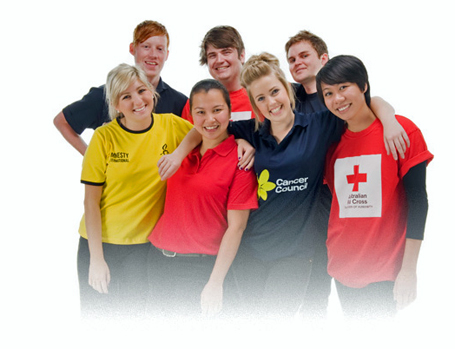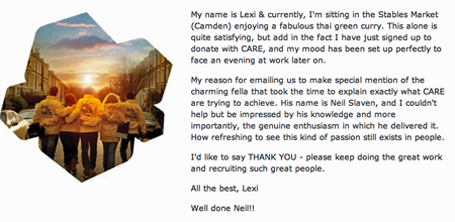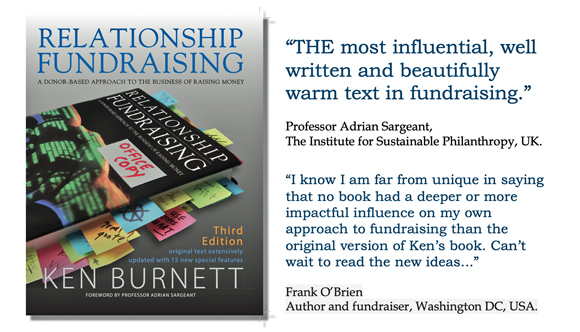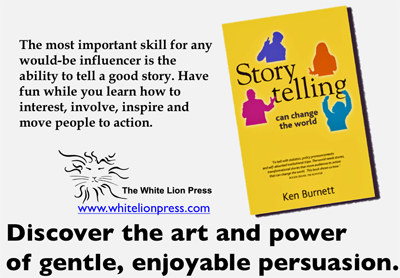| |
 Opinion Opinion
from
Ken Burnett, writer, publisher and occasional fundraising consultant.

My mother used to say to me, ‘if you can’t defend it, don’t do it’. This is simple sense, a question not of fundraising dos and don’ts but of moral fibre...

...the people charged with doing F2F are denied such investment by a client class that is generally risk-averse, driven by an over-riding desire to drive down unit costs, blinkered by ignorance of how F2F works and might improve, and too junior to recognise opportunities even when they stare them in their own face.

More blogs on fundraising and communication
• The speaking event from Hell.
• The Happy Bubble.
• Seize the day – on missed opportunities.
• How to turn talk into action.
•Is it time for Twitter suicide?
• The future of fundraising.
• Is direct mail dead?
• The donor pyramid isn’t well either.
• The fundraising dream team.
• The transformational fundraising entrepreneur.
• The indispensable guard book.
• Prepare for the fundraising trustee.e.
Books by Ken.
Other feature articles.Home page.
Readers’ comments.

Tales from The Field by the River:
• Animal intelligence,
• The adventure of the five white bulls.
• Rough sex down by the river.
• Alzheimer’s disease has stolen my great friend.
And also a special
from the distant past,
A Sudan safari.
|
I’ve just been through a quite shocking encounter. Last week, with my colleagues Alan Clayton and Jacob Rolin, I spent three intensive days in the company of 16 dedicated, experienced, highly effective professional fundraisers. What’s shocking about that, you may wonder? Well this group, we discovered, are marginalised, misunderstood and under-appreciated by many if not most other professional fundraisers. While they raise more £millions for our leading charities more cost effectively than most other fundraisers, this group see themselves as under-supported misfits who the majority of their professional colleagues would rather didn’t exist at all.
I’m talking about professional face-to-face fundraisers. They’re the people who talk to our potential new donors, one by one, on the street. They’re the people who other professional fundraisers commission to engage, entice and persuade new donors to sign direct debits using this recently established though thoroughly tested mass communication method that many fundraising managers disdain, looking down their noses at it as if it smells.
As I heard the group’s stories of client abuses and lack of support and these realisations dawned, suddenly I felt ashamed of myself and my profession.
I declare some past history. Back in the mid 1990s George Smith and I were commissioned by Daryl Upsall and Jasna Sonne at Greenpeace International (see here) to spread the monthly giving message around the Greenpeace world. Among other places this took me to Austria where I worked with the team that went on to introduce monthly giving to that country. And where, soon after, Greenpeace developed its now famous direct dialogue approach and the phenomenon of face-to-face fundraising (F2F) as we know it, was born.
The fundraising acquisition paradigm had changed, irrevocably.
I was proud of such an instant and substantial success, but wrote afterwards that I was still sitting on the fence about the future of F2F because I was concerned about how fundraisers would use it, how in time we might kill our golden goose if the public started to cross the road to avoid us.
I thought this caution might result in our sector refining and developing F2F to make it more involving and interesting, like some of the initiatives showcased on SOFII (see here, here and here).
I now find that the people charged with doing F2F are denied such investment by a client class that is generally risk-averse, driven by an over-riding desire to drive down unit costs, blinkered by ignorance of how F2F works and might improve, and too junior to recognise opportunities even when they stare them in their own face.
It’s not what you do, it’s the way that you do it.
My mother used to say to me, ‘if you can’t defend it, don’t do it’. This is simple sense, a question not of fundraising dos and don’ts but of moral fibre. Do we believe in F2F? We should. And if we do, we should back it enthusiastically and proudly. We should acknowledge that it’s not perfect and we can make it better. We should champion it for what it has done – a lot of good in our world. And those who, after properly looking at it, still don’t believe in it should stop doing it. They should leave the field clear for the rest of us, who certainly will do it better and will improve the public experience as we go.
How much have these professional fundraisers raised in the last 15 years? How many new donors have they brought in?
I don’t know exactly, but for sure it’s £billions, not mere millions. It’s probably tens of millions of new donors too. I base this on a statistic from Greenpeace, who in five years (1996 to 2001) in 18 countries recruited 1.4 million new donors via F2F, giving them an annual income of $150 million.
So F2F fundraisers raise enough money and have recruited enough donors to claim not just that they’re central to our fundraising strategies, but that they’ve literally saved our sector. Because in 1994 the costs of other forms of donor recruitment had gone through the roof. And we didn’t know where to turn.
I remember this. Most people who commission F2F teams now, don’t.
What else good have F2F fundraisers done?
They have introduced a huge number of young people to fundraising, many of whom have graduated from the street to become conventional (or even unconventional) fundraising managers. They are a training school, for our future.
They’re fun. They’re inoffensive. And they recruit more young people into voluntary giving than all other forms of engagement put together. Is that not a good thing? Should we not all be collaborating to refine and improve what they do, rather than looking the other way and hoping they’ll disappear?
Misfits, operating at the margins
Yet despite their contribution our sector treats them like dirt. In a recent televised attack on F2F the programme makers couldn’t find a single senior fundraiser prepared to come on air and defend our sector by standing up for its main recruitment activity.
That is shameful. Heaven knows, the purveyors of direct mail have been given a hard time by clients over the years, treated at times as badly as some folk treat direct mail packs. But our sector treats F2F fundraisers significantly worse.
No proper briefing. A dearth of stories to tell on the street. The FD at one top ten charity refuses to let his F2F agency use the charity’s logo on any material other than clothing, because they don’t want their ‘brand’ to be associated with street fundraising.
But they are quite happy to bank the proceeds from all the donors these F2F fundraisers recruit.
This last week I’ve learned how almost impossibly difficult some clients can be. How disinterested, disengaged and dismissive many of them are. How, to do their job, F2F managers have to deal with junior, inexperienced and untrained clients – clients who try to disguise their lack of expertise or worse, don’t even realise that they lack it.
This does our sector a huge disservice. Surely fundraising leaders can do something about this, and show a lead themselves?
Whatever the future of donor acquisition, this face-to-face business has been a godsend to us, has saved our sector and is likely to be hugely important in delivering large numbers of new donors for a long time to come.
Making face-to-face fundraising better
The main reason that F2F is not given the status and attention of other recruitment methods is that most senior fundraisers dislike it, look down on it and simply don’t understand it.
There is such huge potential for improvements and reinvigoration of the technique, if only clients would get involved and invest in testing and development. And not just defend but champion this most visible and most in-your-face of all public fundraising methods. At our retreat we came up with at least a dozen potentially transformational or reinvigorating ideas worth testing. (Including one real beauty. Clue: most world religions do something similar and it has stood them in good stead for generations.)
If we can’t vigorously promote F2F, with attendant investment and commitment, we shouldn’t do it. End of. There is nothing more to be said.
So, I have a new resolution. Don’t defend F2F, champion it.
Fundraising of course is about uniting donors with beneficiaries. They’re the reason that these young enthusiasts are there, day in, day out, on our cold streets. Not you, Mr or Mrs Fundraising Client, with your nose in the air.
I’m coming off the fence now. I love F2F. I’m going to learn more about it and get very good at it.
How about you?
© Ken Burnett 2011
Storytelling can change the world is reviewed here and here.
 Click the image to register for free updates from SOFII, the Showcase of Fundraising Innovation and Inspiration. Click the image to register for free updates from SOFII, the Showcase of Fundraising Innovation and Inspiration.
|
a50 ideas to improve F2F CChange the way you thinka Readers’ comments

Get to know these people and you’ll be surprised not just by how much good they do, but by how well they do it. And how dedicated they are. You’ll appreciate, of course, there are easier ways to make a living.

We don’t often hear from happy customers such as Lexi. But you can bet that your F2F agency has many testimonials like this.

How much have these professional fundraisers raised in the last 15 years? How many new donors have they brought in?
I don’t know exactly, but for sure it’s £billions, not mere millions. It’s probably tens of millions of new donors too.



Yet despite their contribution our sector treats them like dirt. In a recent televised attack on F2F the programme makers couldn’t find a single senior fundraiser prepared to come on air and defend our sector by standing up for its main recruitment activity. That is shameful.

Comment from Giles Pegram CBE, former director of appeals at NSPCC
Ken, I agree with every word you say, and I think it needs to be said more often by more people. There are four points I’d add.
First, F2F fundraisers are no more intrusive than the formidable ladies who were to be found on our High Streets in the sixties and seventies with their tray of flags. Woe betide you if you weren’t wearing one by the time you got home.
Second, the average gift of a donor recruited this way is higher than any other means, by quite a margin. After initial attrition, they are loyal and have a high lifetime value. These collectors are introducing a new demographic to the joy of philanthropy, young people who are going to get wealthier as they grow older and, having discovered philanthropy, are going to give more of their money away. This is just the start.
Third, while in dialogue with the prospect, they are the embodiment of the cause and all its values. Yet we pay far less attention to what they say about us than we do to any DM pack.
Finally, even within charities, F2F people are known as ‘ chuggers’. This is dreadful.
Giles Pegram CBE
Consultant
07976 065 074
www.gilespegram.com
Also, some useful and perceptive additions to the debate here from Toronto-based donor development expert Penelope Burke, author of Donor-Centred Fundraising.
For other readers’ comments click here. Add your thoughts too.

At the time of writing Ken Burnett is a partner in the Clayton Burnett group of transformational fundraising entrepreneurs. Clayton Burnett works intensively with small groups of fundraisers at the spectacular Inchnacardoch Lodge Hotel on the shores of Loch Ness, where magical things happen.

Ken’s written quite a lot about fundraising and you can find out more about all that here.


|











